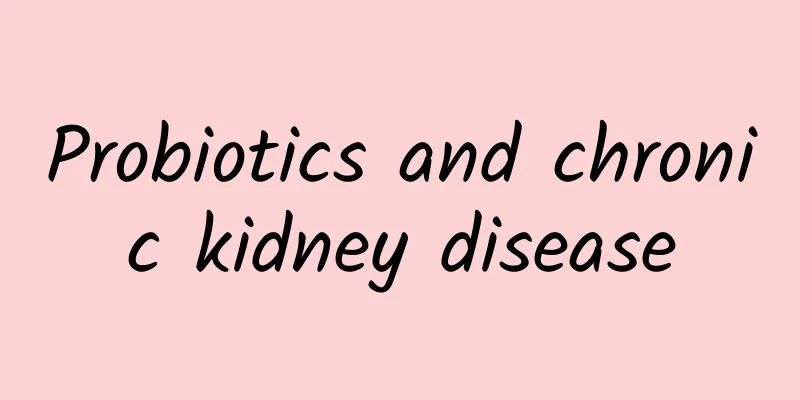Probiotics and chronic kidney disease

|
Among children, there is a special group. They can only eat limited food every day, go to the hospital three times a week, have tubes inserted into their bodies, do dialysis for a morning, and then go home. Most of them are thin, easy to catch colds, and live cautiously. Xiao Xiongmao is such a child. He is 16 years old, diagnosed with chronic kidney disease for 9 years, and has been on dialysis for 8 years. Recently, he didn't want to eat. After his mother gave him some probiotics, his appetite improved a lot. I saw on the Internet that probiotics can be taken for a long time, can regulate gastrointestinal flora, and can also slow down the progression of the disease by hindering the production of intestinal toxins. Chronic kidney disease is a clinical syndrome characterized by disordered kidney structure and long-term abnormal kidney function. The late stage of chronic kidney disease is also called uremia, and life is maintained by dialysis. According to foreign reports, if a suitable kidney source cannot be found, the remaining life expectancy of children receiving dialysis is 22-24 years. The ability to remove toxins by dialysis is limited, so the red panda mother is willing to try any drug that can hinder the production of intestinal toxins. Today, let's take a look at the role of probiotics in chronic kidney disease. 1. Children with chronic kidney disease and intestinal flora imbalance First, renal dysfunction in children with chronic kidney disease can lead to the accumulation of metabolic waste, causing intestinal mucosal ischemia, damaged mucosal barriers, and increased permeability. And due to the presence of chronic inflammation, the growth environment of the flora has changed. Secondly, the nutritional status of children with chronic kidney disease is generally poor, and there is a lack of nutritional substrates for the intestinal flora that are beneficial to the body, thereby inhibiting the growth of the dominant flora. Thirdly, due to the inhibition of the growth of the dominant flora, intestinal peristalsis slows down and sluggishness, and the intestinal clearance capacity is reduced, providing pathogenic bacteria with the opportunity to contact and adhere to the mucosa. 2. Probiotics and toxin removal Hemodialysis can only remove free microorganisms, resulting in very limited removal. Prolonging dialysis time will make children intolerant, so to reduce toxins in the body, it can also be done by reducing production. In one study, it was suggested that preparations containing Bacillus pasteurianus and Lactobacillus acidophilus could reduce blood urea nitrogen and serum creatinine levels. Similar studies have shown that lactic acid bacteria can reduce the levels of enterogenic uremic toxins indoxyl sulfate and p-cresol in the blood and inhibit systemic micro-inflammatory responses. Bifidobacteria can effectively reduce serum TNF-α and IL-6 levels, reduce C-reactive protein levels in maintenance hemodialysis patients, and inhibit inflammatory responses. So, are all probiotics containing the above-mentioned bacteria recommended for use? Unfortunately, there is no such large-scale research at present, and individual studies are not enough to promote. 3. How to use probiotics? Although probiotics are beneficial for children with chronic kidney disease, the relevant guidelines do not routinely recommend the use of probiotics. They are only recommended when there is a clear imbalance in the intestinal flora. In order to make probiotics grow better in the intestines, it is recommended to take prebiotics, which are foods for probiotics, to promote the proliferation of probiotics. Studies have shown that the combination of the two can change the intestinal flora of patients with chronic kidney disease, reduce the production of uremic toxins, and thus slow down the occurrence of cardiovascular complications. Clostridium butyricum and Bifidobacterium, which are commonly used in children, have a bacterial population of 106-107 CFU due to different preparations. However, this order of magnitude of bacterial population is far from enough to remove uremic toxins. Foreign studies have shown that only when the bacterial population reaches 109 will there be a significant effect on toxins, and the greater the number, the better the removal effect. A bacterial population of 16×109 CUF can reduce serum urea levels more than 8×109 CUF. To sum up, probiotics are medicines, and all medicines are toxic. Without extensive safety and effectiveness evaluation, it is best not to give them to children for a long time. References 1.Vitetta L, Gobe G. Uremia and chronic kidney disease: The role of the gut microflora and therapies with pro- and prebiotics[J]. Molecular Nutrition & Food Research, 2013, 57(5):824-832. 2.Miranda Alatriste PV, Urbina AR, Gómez Espinosa CO, et al. Effect of probiotics on human blood urea levels in patients with chronic renal failure[J]. Nutricion Hospitalaria, 2014, 29(3):582-590. 3.Wang IK, Wu YY, Yang YF, et al. The effect of probiotics on serum levels of cytokine and endotoxin in peritoneal dialysis patients: A randomized, double-blind, placebo-controlled trial[J]. Beneficial Microbes, 2015, 6(4):1-8. 4.Taki K, Takayama F, Niwa T. Beneficial effects of Bifidobacteria in a gastroresistant seamless capsule on hyperhomocysteinemia in hemodialysis patients[J]. Journal of Renal Nutrition, 2005, 15(1):77-80. |
Recommend
What causes excessive menstrual blood clots?
Adult women normally have their menstrual period ...
Can I eat ice cream when I'm pregnant?
You cannot eat cold food when you are just pregna...
Symptoms of pelvic effusion
Pelvic effusion is a very common gynecological di...
Can women wear sports bras on a daily basis?
The importance of underwear to women is self-evid...
Several Commonly Used Chinese Medicines for Tonifying the Kidney
Nowadays, the trend of kidney tonification is pre...
9 foods that women with dysmenorrhea should avoid eating before menstruation
Dysmenorrhea bothers a large number of women, but...
Bleeding after medication abortion for a few days
Medical abortion, also known as medical abortion,...
Will young people develop age spots if they stay up late? Young people do develop age spots, but the reason is...
Rumor: "Young people who stay up late will d...
Abdominal pain after menstruation
Most women nowadays show a kind of sick beauty ph...
Can I caress during early pregnancy?
After pregnancy, women's emotions will fluctu...
What causes cold hands and feet in women?
What causes cold hands and feet in women? Many wo...
What does menopause mean?
When women reach menopause, they have usually ent...
High fever and cough after swimming? Can you still play in the water in summer?
recently A swimming pool in Sichuan Many children...









